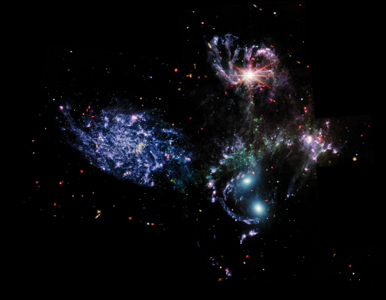
McKay, who's leading a team of 11 scientists from across the university examining centaurs that live beyond Jupiter, became one of the first people on the planet to use JWST when he logged the first of 26.3 hours on the $10 billion telescope—the largest and most powerful space observatory ever built—in July.
Q. The first images were, ahem, out of this world. What resonated most with you?
A. One of the coolest ones I saw was the spectrum of the exoplanet. Initially, the plan for James Webb was to observe these very high redshift galaxies right after the Big Bang, or as close to it as possible. But over the course of JWST’s [20-year] development, we discovered that exoplanets are very common in other planetary systems. So just to see that spectrum, to be able to characterize the atmosphere for another exoplanet at that level of detail—that’s what stood out most to me.
Q. What are centaurs?
A. Centaurs are ice-rich bodies that orbit the sun between the orbits of Jupiter and Neptune. They’re interesting because, like comets, asteroids, and other smaller bodies, they’re primitive leftovers from the formation of our solar system.
About 4.6 billion years ago, our solar system formed out of a disc of gas and dust that surrounded the forming sun—and it was from that disc that every other object in the solar system [originated]. And while the major planets have undergone changes over time—like geology occurring on the surface of Earth—these objects have not. So, we use them as fossils or time capsules to better understand the physics and chemistry that were going on during the very early stages of planet formation.
And while centaurs are interesting, we know very little about them because they’re so far away and relatively small as far as objects in the solar system go. We haven’t really been able to characterize their composition—but that’s where James Webb comes in.
Q. Why centaurs?
I come mostly from a background in comets, [which] I studied for a very similar reason: to understand the composition—particularly the composition of this icy material—and to then try and link it back to models of the early solar system.
Centaurs seemed like a natural extension of that because a lot of them are probably precursors to some of the comets we see today. Eventually, their orbits will continue to evolve inward, and they’ll become like some of the comets that we’ve been able to study a bit more today.
That’s another big question we have: Even though these objects are primitive, there are some changes occurring because they’re being heated by the sun and the ices are sublimating. So, are there significant changes that happen between the centaur stage and that comet stage? I think the JWST observations will be the first step to answering that.
Q: How long after you used JWST for the first time in late July did you receive images and data?
It was actually very quick. We received the data one day after the observations were taken. Because the turnaround was much quicker than I expected, there actually wasn't much anticipation, just a pleasant surprise when I received the notification and an eagerness to look at what we got.
Q: And what did you get?
We were able to confirm the presence of our target object in our data and look at the spectra we obtained. While certainly not as aesthetically pleasing as the JWST images that were released to the public [in early July], it was in line with what we expected to get. We look forward to further analyzing the data we got and gathering more of it on additional targets over the next year.
Q. What excites you most about your work with JWST?
A. What it’s going to be able to do for our knowledge about exoplanets. That’s at the forefront of astronomy right now: characterizing exoplanets to find if any have an atmosphere similar to Earth’s and [to determinine] how common Earth-like planets are in galaxy.
Q. Why is that important?
A. One of the biggest questions humankind has been asking for millennia is: Are we alone? Is Earth the only place in the universe that has life on it, or is life common throughout the galaxy and the universe? We’re interested in planets similar to Earth—kind of rocky with a lot of water and oxygen and similar atmospheric composition and temperature. Right now, we can [only] identify Earth-like planets more or less by size. So, we can say, ‘It’s a similar size and it’s probably rocky, but we don’t know much else.’ But JWST will be able to take the next step, determining composition and temperature—and if it’s similar to Earth, it might have life on it.
Q. What sparked your interest in outer space?
A. I can trace it back to when I was 10, around the time that Comet Hyakutake and Comet Hale-Bopp had their really bright apparitions. That got me interested in comets. Then my dad took me to a planetarium show and from there, I was hooked on space.
As a 10-year-old, you have a lot of dreams, but you never know whether they’re going to happen. The fact that I’m talking to you from a NASA facility, and that I get to use NASA’s latest cutting-edge instrument facility to do cool science and hopefully help us better understand the universe—that’s a dream come true.